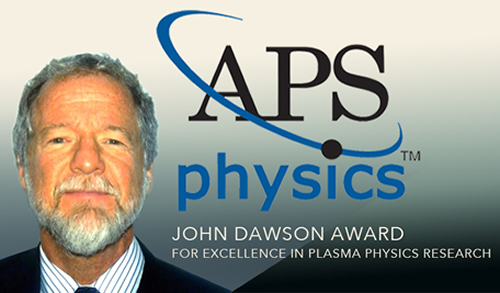NIF & PS People - 2018
July
Tammy Ma Selected for DOE Early Career Award
LLNL Fusion Scientists Receive Awards
Two Laboratory plasma physicists have received national recognition for their work in magnetic and laser fusion.
Max Fenstermacher
Magnetic fusion physicist Max Fenstermacher has been awarded the 2018 John Dawson Award for Excellence in Plasma Physics Research from the American Physical Society. He is cited jointly with Todd Evans of General Atomics and Richard Moyer of the University of California, San Diego.
Fenstermacher’s team was cited “for the first experimental demonstration of the stabilization of edge localized modes in high-confinement diverted discharges, by application of very small edge-resonant magnetic perturbations, leading to the adoption of suppression coils in the ITER design.”

ITER is an international nuclear fusion research and engineering megaproject, which will be the world’s largest magnetic confinement plasma physics experiment.
The Dawson award recognizes a particular recent outstanding achievement in plasma physics research. The award consists of $5,000 to be divided equally in the case of multiple recipients, and includes a certificate citing the contributions made by the recipient or recipients to be presented at an award ceremony at the Division of Plasma Physics annual meeting banquet.
Fenstermacher, Evans and Moyer performed experiments that proved edge magnetic plasma instabilities in toroidally confined fusion plasmas, known as Edge Localized Modes or “ELMs,” can be stabilized by applying small 3D magnetic perturbation fields.
ELM stabilization was predicted and confirmed experimentally by an international team of physicists in the DIII-D tokamak at General Atomics and published in a 2004 issue of Physical Review Letters and a 2006 issue of Nature Physics. Analysis of DIII-D data showed a correlation between the effectiveness of ELM mitigation and the width of the region in the plasma edge where the induced magnetic islands overlapped. The analysis suggested a threshold width of island overlap to achieve full ELM stabilization.
This threshold was used to make the initial predictions of the magnetic perturbation amplitude required to suppress ELMS in the ITER tokamak, which in turn guided the design of a proposed set of internal ELM control coils for ITER, currently under construction in France. These results have since been reproduced in tokamak experiments in South Korea, China and Germany. The suppression of these edge plasma instabilities is critically important for preventing damage to vacuum vessel walls of high power fusion reactors such as ITER. Based on the success of this approach, the ITER organization added a set of internal 3D perturbation coils similar to those in DIII-D in the baseline design of the device.
Critical System
“I’m honored to be part of the team recognized for our pioneering work on ELM control with 3D magnetic fields in the DIII-D tokamak,” Fenstermacher said. “The period from 2004-10 was an intense time of experimentation and attempts to extrapolate the results, as the ITER project grappled with the difficult decision of whether to add expensive ELM control coils to the device. I very much appreciate the recognition from the APS-DPP that our work was essential to the decision to add the coils, which are now viewed as a critical system to assure ITER’s success.”
Fenstermacher has been a physicist in the Magnetic Fusion Energy Program at LLNL since 1988. He graduated with a double major in mathematics and physics from Kalamazoo College and completed his master’s degree and Ph.D. in nuclear engineering (plasma physics) at the University of Michigan. He began his career in 1983 on location at LLNL as a member of the TRW plasma physics group supporting the MFTF-B tandem mirror. In 1988, he became a member of the LLNL staff, supporting the Microwave Tokamak Experiment (MTX) to couple the ALCATOR-C tokamak to a Free Electron Laser (FEL). Since 1994, he has been located off-site as a member of the LLNL experimental team at the DIII-D National Fusion Facility in San Diego.
Fenstermacher is a member of Phi Beta Kappa, Tau Beta Pi and the APS. He serves as a U.S. representative to the ITER Science and Technical Advisory Committee, has been the chair of the ITPA ELM Control working group since 2008, and has served for eight of the last 10 years as the experimental coordinator for the DIII-D tokamak program at General Atomics.
Bruce Cohen
LLNL retiree Bruce Cohen was selected as the recipient of the 2018 IEEE Nuclear and Plasma Sciences Society’s Charles K. Birdsall Award for “contributions to the numerical simulation of plasmas, particularly multiple time-scale methods and to their application to diverse plasma physics problems, from laser-plasma interactions to tokamaks.”

The Birdsall Award recognizes outstanding contributions in computational nuclear and plasma science, with preference given to areas within the broadest scope of plasma physics encompassing the interaction of charged particles and electromagnetic fields.
“I am elated to receive the IEEE NPSS Birdsall Award,” Cohen said. “It is very gratifying to have one’s research career in physics recognized with this award. I am very thankful to my supervisors and colleagues at LLNL and DOE for creating a great environment and supporting my work for the past 42 years. I have a special connection to Ned Birdsall as he was one of my professors at UC Berkeley and on my Ph.D. thesis committee, and I worked with him on a number of projects at Berkeley and later at LLNL.”
Cohen received his bachelor’s degree in physics with distinction and honors at Harvey Mudd College and his master’s degree and Ph.D., both in physics, from UC Berkeley.”
He worked as a physicist at LLNL from August 1976 to his retirement in January 2017. He was a group leader for Theory and Computations in the Fusion Energy Sciences Program at LLNL from 2007 to 2016 after being the deputy group leader from 1998 to 2016. He was elected an American Physical Society Fellow in the Division of Plasma Physics in 1987 and served as an associate editor for both the Journal of Computational Physics and Physical Review Letters.
Cohen has served on numerous committees for the American Physical Society Division of Plasma Physics and the Department of Energy’s Office of Science, Fusion Energy Sciences. His research has addressed plasma and computational physics topics in magnetic confinement fusion, laser fusion, space and astrophysical plasmas, radio-frequency heating of plasma, parametric instabilities, nonlinear beat-wave processes, linear and nonlinear theory of microinstabilities and turbulent transport, and the application and development of particle and fluid plasma simulation and multiple-time-scale computational methods. He has authored or coauthored more than 160 refereed journal publications and chapters in two books.
Tammy Ma Selected for DOE Early Career Award
NIF & Photon Science plasma physicist Tammy Ma has been named a recipient of the prestigious Department of Energy Office of Science Early Career Research Program (ECRP).
Now in its ninth year, the program is designed to bolster the nation’s scientific workforce by providing support to exceptional researchers during the crucial early career years, when many scientists do their most formative work.
 Tammy Ma
Tammy Ma “Supporting talented researchers early in their career is key to building and maintaining a skilled and effective scientific workforce for the nation,” said Secretary of Energy Rick Perry. “By investing in the next generation of scientific researchers, we are supporting lifelong discovery science to fuel the nation’s innovation system. We are proud of the accomplishments these young scientists have already made, and look forward to following their achievements in years to come.”
Ma will receive a total of $2.5 million over five years to conduct research for her proposal, “Multi-ps (picosecond) short-pulse laser-driven particle acceleration for novel HED (high energy density) and ICF (inertial confinement fusion) applications.”
“I am so grateful for everything the Lab has provided to allow me to thrive,” Ma said, “an incredibly nurturing environment, freedom and support to be innovative, the LDRD (Laboratory Directed Research and Development) grant that laid the groundwork for this project, mentors that continuously encourage me and the family of colleagues that makes it fun to come to work every day.
“I’m honored to receive this award, and the coolest part is that I’ll get to extend the work of many of the LLNL giants that came before—this type of short-pulse particle acceleration was first discovered on the Nova laser (NIF’s predecessor), and now I get to use NIF ARC (Advanced Radiographic Capability) to push it forward into the multi-picosecond, high-energy regime.”
Ma earned her bachelor’s degree in aerospace engineering from Caltech in 2005 and received her master’s degree in 2008 and Ph.D. in 2010, both from the University of California, San Diego. Following graduate school, she completed a postdoctoral appointment at LLNL before becoming a staff scientist in 2012.
She currently serves as chair of the Lab-wide LDRD Program and as the X-Ray Analysis Group lead for LLNL’s ICF program at NIF. Ma has authored or co-authored more than 140 peer-reviewed journal publications and has been recognized with the Stix Award for Outstanding Early Career Contributions to Plasma Research by the American Physical Society and the Presidential Early Career Award for Science and Engineering, the highest honor bestowed by the U.S. government on science and engineering professionals in the early stages of their independent research careers.




